The seemingly inexhaustible oceans have proved to be finite after all. Landings of wild fish have levelled off since the mid-1980s, and many stocks of fish have been so heavily over-fished that their future is threatened.
Yet, the world’s appetite for fish has continued to grow, particularly as urban populations and incomes grow in developing countries. Aquaculture fish farming has emerged to meet this increased demand.
Production of fish from aquaculture has exploded in the past 20 years and continues to expand globally, with production rising from 99 million tonnes in 1990 to 122 million tonnes in 1997.
Despite the surge in aquaculture production worldwide, there is still a need to intensify efforts in fish production to meet the ever-growing demand, with a projected global supply deficit of 1 million tonnes by the year 2010.
Nigeria, the second-largest aquaculture producer in Africa after Egypt, has increased production from 18,000 tonnes in 1990 to 25,000 tonnes in 1997. The country still possesses the potential to produce more, provided there is proper utilization and harnessing of aquatic resources, including freshwater bodies, lakes, and reservoirs for fish production.
Understanding Aquaculture Systems
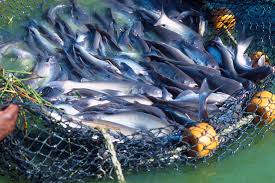
Aquaculture can simply be defined as the raising of aquatic organisms, including plants and animals, with a focus on fish production. The systems can be grouped into three categories, similar to the culture systems of other livestock.
1. Extensive Aquaculture System
In this system, fish are raised to depend solely on the pond’s natural production capacity. Yield per unit area is usually low, characterized by low inputs, low stocking density, and the availability of plankton and other live food materials in the pond, aided by fertilization. Overall pond yield is very low, making it unsuitable for large-scale commercial purposes, with yields typically around 500kg per hectare.
2. Intensive Aquaculture System
This system utilizes supplemental (or artificial) feeds, often high-level protein-rich diets, to meet the nutritional requirements of fish. Other management practices are also intensive, including medication, constant good water quality supply (flow-through or recirculatory systems), resulting in high yields per unit area. Yields can reach up to 50 tonnes or more per hectare.
3. Semi-Intensive Aquaculture System
Under this system, ponds are fertilized to enhance phytoplankton growth, and supplemental (artificial) feed is also applied, though often in smaller quantities. The feed may not be pelleted, as in intensive systems, but can include locally available organic wastes such as kitchen wastes, brewery wastes, rice bran, and groundnut cake. Yields are moderately higher than in extensive systems but not as high as in intensive aquaculture systems.
Read Also: Popular Breeds of Ruminant Animals
Purpose of Fish Farming
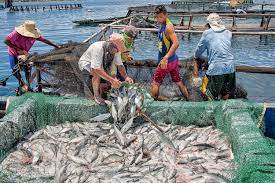
Unfortunately, the term “fish farming” often suggests large-scale commercial enterprises directed at producing food fish for marketing in restaurants and supermarkets. This common misconception misleads in many respects.
First, many successful fish farming ventures are small, family-run, “backyard-type” operations that produce a limited number of food fish for sale in local markets.
Second, many fish farms do not grow food fish at all but instead rear eggs and fingerlings (2-4 inch fish) for sale to food fish producers, fingerling sport fish for stocking in private ponds and streams, catchable-sized sport fish for stocking in recreational ponds and fee-fishing waters, bait minnows, frogs, crayfish, worms, and aquatic insects for sale to anglers as fish bait, or goldfish, tropical fish, turtles, and other aquatic animals and plants for sale as aquarium pets.
Finally, many successful fish farms are non-commercial, hobby-type operations that simply grow fish for home use and stocking personal recreational fishing ponds.
Table 1: Fish Farming Purposes
| Non-Commercial | Commercial |
|---|---|
| Home-Use | Food Fish Production |
| Personal Recreation Fishing | Egg and Fingerling Production |
| Personal Fish Bait Production | Catchable-sized Sport Fish Production |
| Fish Bait Production | |
| Aquarium Pet Production | |
| Fee-fishing/Fish-out Pond Production |
Of the two major types of fish farming (non-commercial and commercial), growing fish on a non-commercial basis for home-food use or personal recreational fishing is the easiest and least expensive way to begin fish farming. Most fish farmers start small by growing a few fish for fun and expand to large-scale commercial operations only after gaining the necessary skills and experience.
Commercial fish farming is a time-consuming, expensive, high-risk business that requires careful planning, a good understanding of fish biology, and sound business management skills. A careful study of economic considerations, especially product demand, financing, production costs, and marketing, should be conducted before investing in a commercial fish farm.
Table 2: Typical Fish Farming Costs
| Capital Costs | Operating Costs |
|---|---|
| Land | Fish |
| Pond Construction | Feed |
| Buildings | Electricity |
| Hauling Trucks | Fuel |
| Water Supply | Labour |
| Plumbing and Pipes | Transportation |
| Hauling Tanks | Maintenance |
| Aerators | Chemicals |
| Oxygen Meter | Drugs |
| Nets and Seines | Telephone |
| Waders and Boots | Taxes |
| Feeding Equipment | Interest |
| Tractors and Mowers | Insurance |
Fish Pond Preparation and Management
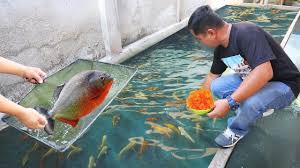
Effective management plays a vital role in the success of aquaculture businesses, both on large and small scales. Effective management can be defined as the proper and timely maintenance of the farm to meet human needs.
This includes successful broodstock manipulation, seed production, stocking, sorting of fish into sizes, disease and pest/predator control, proper water management, control of human poaching, timely harvesting, marketing, and adequate record-keeping.
Scientifically, farm management considers basic economic principles in business management, including comparative advantage, diminishing returns, substitution, cost analysis, opportunity cost, enterprise choice, and goal trade-off. However, despite the prudent application of these principles, effective, prompt, and timely decisions must be made.
Data collected and analyzed based on these principles cannot make decisions by themselves but must be harnessed by an expert in the field (manager) to make rational decisions. The decision-maker must be well-equipped with good reasoning skills, economic knowledge, and management expertise, as they must choose between different alternatives, some of which have uncertain consequences.
Personal elements, including perceptions of risks and attitudes toward consequences, play a major role in the final decision, even though it is preferable to handle complex decisions with more than just intuition.
The amount of effort and time spent on decision analysis depends on the importance of the decision, the time available, and the cost involved in the analysis. Even a simple analysis, consisting of evaluating various choices and scrutinizing the consequences of each, can lead to better management decisions.
Site Selection for Fish Farming
All meteorological and hydrological information about the area, such as range and mean monthly rainfall, evaporation, sunshine, wind speed and direction, flood, and water table, must be assessed. In inland aquaculture, the most commonly used installations are earthen pond farms (rearing and nursery ponds) and hatcheries.
Therefore, soil characteristics, the quality and quantity of available water, and the ease of filling and drainage by gravitational pull are essential. The nature of site vegetation indicates the soil type and elevation of the water table.
Dense vegetation, particularly tall trees, makes clearing more difficult and expensive, while a high groundwater level may create problems of poor drainage and inconvenient use of mechanical equipment for pond construction.
Pond Construction for Fish Farming
The pond is the environment in which fish live and where all activities relating to their life take place, from stocking to cropping. Ponds may be earthen or tank-based. Earthen ponds can be either drainable or undrainable. Drainable ponds are constructed so that water flows into the pond easily by gravity via inlet pipes from its source and can be easily emptied by gravity through outlet pipes buried into the soil.
No mechanical energy is needed for these operations, which, although slower, saves costs. Undrainable ponds may have inlet pipes to bring water into the pond but cannot be emptied except by mechanical aid (pumping machines), increasing production costs.
However, practical experience has shown that the construction and operation of a farm with a pumped water supply system can be more economical than that of a tidal water farm.
Fish tanks may be made of concrete, fiberglass, plastic, or wood and come in various sizes and shapes, ranging from circular to rectangular to trapezoidal forms for different sizes of fish. They can be subsurface or completely surface-based and should be protected with locks to prevent human pilfering.
Soil Testing for Fish Pond Construction
Soil analysis of the intended fish pond site is an often-overlooked but crucial activity. The quality of soil is important in pond farms, not only because of its influence on productivity and the quality of the overlying water but also because of its suitability for dyke construction.
The ability of the pond to retain the required water level is also greatly affected by soil characteristics. Soil tests range from simple visual and tactile inspections to detailed subsurface exploration and laboratory tests. Sandy clay to clayey loam soils are considered suitable for pond construction.
Texture (relative proportion of sand, silt, and clay particles) and porosity are the two most important physical properties to examine. By touch and feel, one can determine the texture of a soil sample.
A sample that can be kneaded and rolled into a bar and bent to form a ring around the thumb without cracking is clayey. If it cannot be made into a bar and remains separate with visible grains when dry, the sample is sandy. If the sample does not fall into either category, it can be categorized as silt or loam.
Read Also: Proper Layers Management Practices for Better Performance
Water Availability for Fish Farming
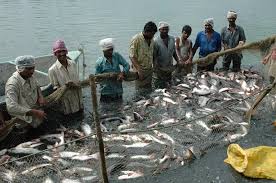
The availability of good water, both in terms of quality and quantity, is essential for successful fish farm operations. The availability of water in the required quantity is particularly important in land-based aquaculture systems.
It is therefore recommended to thoroughly investigate the extent and seasonality of water sources, as well as the liability to pollution from agricultural run-offs, industrial effluents, sewage disposal, and flooding.
Toxic substances in water supplies can affect aquaculture, particularly in hatcheries, so regular sampling of pond water must be done to prevent crises on the farm. Important water quality parameters for aquaculture include pH, dissolved oxygen, nitrite-nitrate ratio, temperature, and alkalinity.
Groundwater from springs, wells, or underground seepage is the best source of water for fish farms. Other sources, including surface waters, runoff water, and even municipal water, can also be used to grow fish. However, all water sources must be free of fish diseases and parasites, nuisance fish, predators, silt, pesticides, chlorine, and other chemicals harmful to fish life.
A good water supply of sufficient quantity and quality is absolutely essential for all fish farms. Water quality also restricts the type of fish that can be reared and production rates.
In cases where the water source is seasonal but abundant at the peak of the season, it is common practice in certain parts of the world to impound water for aquaculture purposes, with a water control device called a spillway installed where the farm is susceptible to flooding. Before developing a fish farm, it is crucial to have your watershed tested.
Pond Preparation for Fish Farming
The pond is completely drained of water, and the bottom is allowed to dry until it cracks. Desilting is done if the pond is very muddy. The pond must be in proper shape and good condition if the culturist’s purpose, aims, and objectives are to be realized. Therefore, the following operations are recommended before stocking the pond with fingerlings (baby fish):
1. Drying the Pond Bottom: The pond must be completely drained of water, and the bottom is allowed to dry until it cracks. Desilting should be carried out if the pond is muddy.
2. Removal of Unwanted Organisms and Aquatic Weeds: While drying the pond, undesirable organisms such as frogs, mollusks, fish predators, and aquatic weeds like water hyacinth, Pistia, and Lemna are removed. After this, the pond is fenced, and all inlet and outlet pipes are properly screened while surrounding vegetation is kept low.
Dense aquatic vegetation occurring either along the pond margin or inside the pond must also be controlled. These weeds compete with phytoplankton for available nutrients in the pond water, diminishing overall pond productivity.
Unwanted organisms like lizards, reptiles, crabs, and birds must be chased out or killed, while aquatic macrophytes can be removed manually, mechanically, or biologically using herbivorous fish species like Distochodus spp. or grass carp.
3. Repair of Pond Structures: The essence of site survey and farm planning is to ensure convenient and effective utilization of pond or farm facilities once they are properly constructed. However, it is essential to ensure that adjoining pond structures such as embankments and monks are checked and repaired if necessary, and all cracks and holes are sealed before the pond is filled with water.
Similarly, fish screens and water filtering structures, if clogged, should be thoroughly cleaned or replaced, damaged pipes should be replaced, and eroded dykes should be strengthened before stocking the pond with fish. These activities are synonymous with ensuring the safety of the entire business by minimizing risk sources.
Liming and Fertilization of Fish Ponds
Liming is done to improve conditions for fish production, not in the form of fertilization but to create favorable edaphic conditions in the pond to increase productivity. It also increases soil pH, creating more available carbon dioxide for phytoplankton to photosynthesize.
When pH increases, water is prevented from becoming acidic, and pond mud enhances the solubility of phosphates. Adequate liming aids the flocculation of colloidal particles and soil microbial activities, increasing the rate of decomposition of organic matter and nutrient cycling.
Materials commonly used for liming fish ponds include calcium oxide (quick lime), calcium hydroxide (hydrated lime), agricultural limestone, basic slag, and liquid lime.
In the absence of these, wood ashes can also serve the purpose but require a large quantity to achieve the desired performance. The rate of lime application varies with pH and the amount of clay and organic matter present in the pond.
Agricultural limestone and basic slag are the only liming materials that can be applied in large quantities before stocking and even after stocking the pond with fish for some make-ups. Calcium oxide and calcium hydroxide can be toxic to fish and should be applied in small quantities only before stocking due to their toxic effects.
Liming rates range from 200-1000kg/ha, depending on the potency of the material. Higher application rates are for materials like agricultural limestone, while lower rates are for materials like calcium hydroxide.
The pond is immediately filled with water to a depth of about 0.6m and left for 2-4 days to observe any leakages or seepages. It is later filled to the required depth and fertilized.
Fertilization is done to make water more productive by aiding the growth of natural fish food organisms (plankton). Inorganic fertilizers like urea and NPK and organic manures are the two basic types of fertilization materials used.
Stocking Fish Ponds
Stocking a pond means releasing an adequate number of selected fish species of uniform size to be cultured over a specified period. Stocking is usually done a week after fertilization. The stocking density (number of fish species per unit area) depends on the system of culture, which may be monoculture or polyculture.
Fish fingerlings for stocking ponds can be produced by the farmer or purchased from a reputable hatchery and are transported either early in the morning or in the evening. During stocking, fish should be lowered carefully into the water and allowed to swim out of the container after acclimation to avoid further stress.
The pond should be visited the following morning to check for mortalities, which should be removed and replaced with healthy ones from the same source if found. Culturable fish species in Nigeria include Clarias gariepinus, Oreochromis niloticus, Heterobranchus bidorsalis, Lates niloticus, Gymnarchus niloticus, Chrysichthys nigrodigitatus, Heterotis niloticus, and many species of shellfish like oysters and prawns.
There are many reasons for raising fish, and available resources are of diverse quality, so it is important to examine all existing factors before deciding which species to culture.
Species Selection for Fish Farming
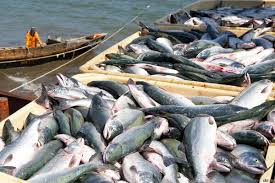
A wide variety of freshwater fish and other aquatic animals can be farmed in Nigeria. Table 3 lists the types most frequently considered, with particular appeal to the masses. Each species has been assigned a farming potential rating based on available information, previous grower experience, and current economic conditions.
These ratings can change with new research, technological advancements, and changing market values. The ratings range from growing optimism (very good) to guarded pessimism (poor). However, these ratings should not discourage adventurous fish farmers with sufficient land, water, and economic resources from trying to grow fish with a poor rating or other species not on the list.
Table 3: Consumers Ratings and Availability of Fish Species for Production
| Species | Consumers Acceptability | Availability of Fish Seeds for Stocking | Feeding Habits | Remarks |
|---|---|---|---|---|
| Heterobranchus bidorsalis | Good | Seasonal | Omnivorous | Responds well to fertilizer and supplementary feeding |
| Distichodus engycephalus | Good | Seasonal | Herbivorous | Keeps aquatic weeds under control in ponds |
| Malapterurus electricus | Good | Seasonal | Predator | Good species for combination with Tilapia in polyculture |
| Maglops atlanticus | Good | Seasonal | Predator | Comes into ponds with tides |
| Cyprinus carpio | Very Good | Year-round and adequate | Omnivorous | Responds well to fertilizer and supplementary feeding |
| Ictalurus punctatus | Very Good | Year-round and adequate | Feeds on insects and crawfish | Responds well to fertilizer and supplementary feeding |
| Clarias gariepinus | Good | Year-round but inadequate | Omnivorous | Responds well to fertilizer and supplementary feeding |
| Oreochromis niloticus | Very Good | Year-round and adequate | Omnivorous | Responds well to fertilizer and supplementary feeding |
Source: Adapted from Ezenwa (1979)
The Ideal Fish for Farming
Although there is no “perfect” fish for farming, the following are desirable biological and economic attributes when selecting the best fish to farm:
- Capable of reproducing in captivity
- Produces numerous and hardy eggs and larvae (young)
- Has well-known culture requirements
- Adaptable to many types of culture systems
- Adaptable to multi-species farming (polyculture)
- Exhibits rapid growth to a large maximum size
- Readily adapts to artificial feeds
- Tolerant of crowding and high-density conditions
- Exhibits high survival (low mortality) rates
- Easy to handle, harvest, and transport
- Resistant to disease and parasite infestations
- Not cannibalistic or territorial
- Readily available as eggs, fingerlings, and adults
- Has high market demand
- Exhibits high feed conversion rates
- Has good dress-out weight values
- Has a long shelf life
- Easy to process
- Has a healthy appearance and color
- Has good eating qualities
- Has highly regarded fighting abilities
- Is catchable
These attributes help ensure the success and profitability of fish farming operations.
Do you have any questions, suggestions, or contributions? If so, please feel free to use the comment box below to share your thoughts. We also encourage you to kindly share this information with others who might benefit from it. Since we can’t reach everyone at once, we truly appreciate your help in spreading the word. Thank you so much for your support and for sharing!
Read Also: How To Raise Chickens – The Simple Secrets To A Great Backyard Flock
